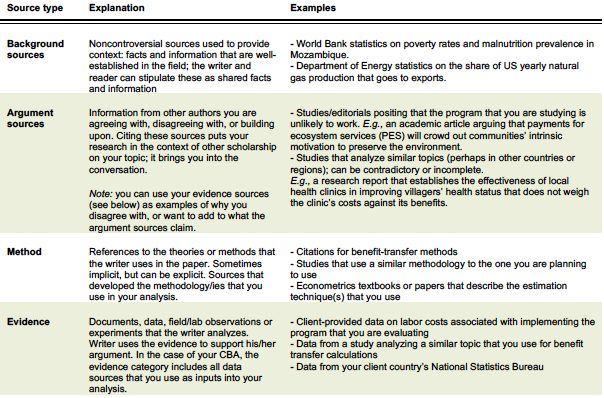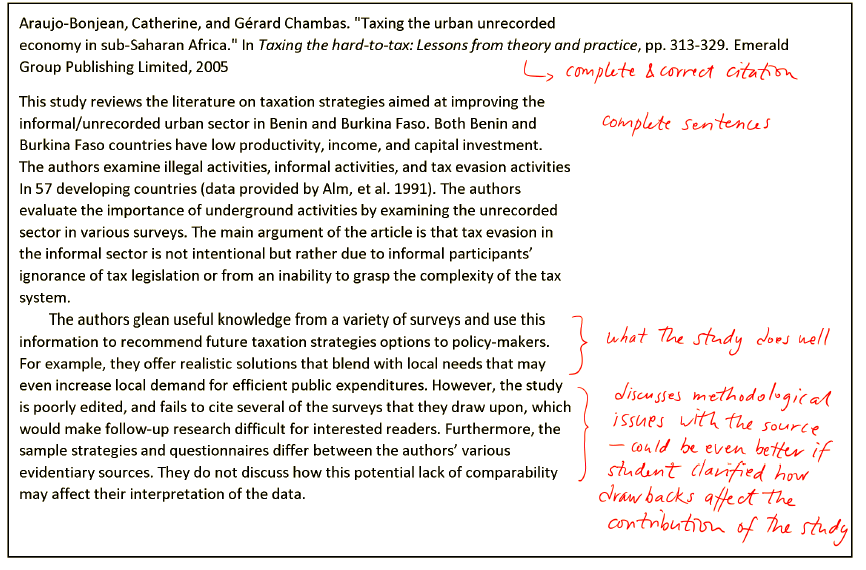PROFESSOR EMILIA TJERSTROM
Learning goals
In this assignment, you will begin building the portfolio of resources that will eventually form the foundation for your cost-benefit analysis. Successful completion of this assignment will feed directly in to the overall course objective of learning to “read, comprehend, and effectively summarize policy research and policy-relevant academic research.” Specifically, after completing this assignment…
• you will have a firm grasp on different types of scholarly sources and how to access them.
• you will better understand how to break down a piece of writing into its component parts and analyze the arguments.
• you will be familiar with writing original annotations able to restate complex concepts in your own words, and write original annotations.
What is an annotated bibliography?
An annotated bibliography is a list of citations to books, articles, reports, etc. Each citation should be followed by two brief paragraphs: one that is descriptive and one that is evaluative. These two paragraphs constitute the annotation. The purpose of an annotation is twofold: (i) to summarize the main point of the source; and (ii) to assess of the relevance, accuracy, and quality of the source cited. In this case, your evaluation should center on how informative the source is likely to be for your project.
The first paragraph should summarize the article in your own words. The second paragraph is a short discussion of how this source relates to or informs your project, and/or the limitations of the source. Try to address both the most important insights of the source and its weaknesses. Some questions that you can use to prod a source: Is the source reliable? How credible are the authors and/or their results? Do the authors leave out important content or information? Do the authors have a solid foundation for any causal arguments? To be clear, I expect this second paragraph to include a value judgment.
Creating an annotated bibliography will involve a variety of intellectual skills: careful literature search/review, concise exposition, and succinct analysis. The steps include:
1. Locate and record citations to sources that may contain useful information and ideas on your topic. This first list typically contains many more sources than the final annotated bibliography; you will whittle the list down as you analyze them. Briefly examine and review the items. Choose sources that provide a variety of perspectives on your topic.
2. Cite the source using the appropriate style. La Follette recommends Chicago style author-date (more here).
3. Write a concise annotation that summarizes the central theme and scope of the source. Include at least one sentence that
a. evaluates the quality of the evidence,
b. comments on the intended audience,
c. compares/contrasts this work with another source that you cite, or
d. explains how this work will be useful in your cost-benefit analysis.
Types of sources
Different types of scholarly sources serve different functions in research papers. You may have heard of primary, secondary and tertiary sources, which define sources by their so-called distance from the writer’s subject. I would encourage you to instead categorize your sources based on how you will use them to construct your analysis and argument.
Table 1 shows an adapted version of Bizup’s BEAM schema (Bizup, 2008). Please ensure that you cite at least two sources from the first three categories. You will eventually cite your evidence as well, but for now, focus on background, argument, and method sources.

Common mistakes
The most common mistake that I see is confusing an annotation with an abstract. Abstracts are descriptive summaries, often found at the beginning of scholarly journal articles. Annotations are descriptive, analytical, and critical.
Below is an example of a first-draft annotation that exemplifies several common mistakes. I also include a revised version, which is much better.


